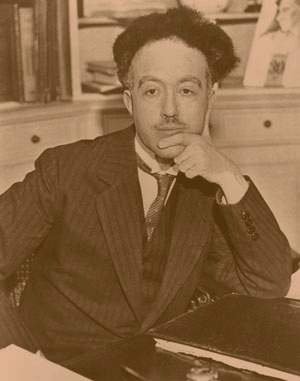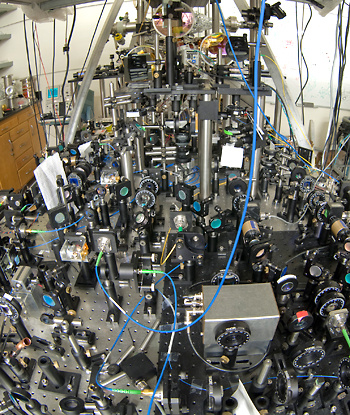Matter Wave Clock
January 25, 2013
One of the more interesting things to come out of the
early days of
quantum mechanics was a prediction by
Louis de Broglie (formally, Louis-Victor-Pierre-Raymond, Seventh duc de Broglie) in his 1924
Ph.D. thèse.[1] De Broglie knew, from independent calculations of
Hermann Minkowski and
Max Abraham, that the
vacuum wavelength (
λ) of a
photon is
Plank's constant (
h) divided by its
momentum (
p); that is,
λ = h/p
I discussed photon momentum in a
recent article (The Pioneer Anomaly, December 19, 2012). De Broglie
conjectured that this
equation was also true for bodies with
mass. We just need to replace
p with the particle momentum,
mv, where
m is the mass, and
v is the
velocity. Such a simple result can be explained on a single page. This, however, was just a part of de Broglie's Ph.D. thèse, "Recherches sur la théorie des quanta," so the thèse was of "standard" size, a little more than a hundred pages.[1]

Louis de Broglie
(Louis-Victor-Pierre-Raymond, Seventh duc de Broglie)
According to a letter written by the duc de Broglie in 1886, "The title of Prince of the Holy Roman Empire was given by the Empress Marie Theresa to the Maréchal de Broglie in 1759, to be worn by him and all his male descendent's."[2]
(Via Wikimedia Commons))
This idea that
matter has a wave nature was proved in an
experiment on electron diffraction by
Clinton Davisson and
Lester Germer at
Bell Labs in 1927. De Broglie was awarded the 1929
Nobel Prize in Physics "
for his discovery of the wave nature of electrons." Davisson shared the 1937 Nobel Prize in Physics for the discovery of electron diffraction, but Germer was notably slighted.
Clocks are made from
frequency sources. The best clocks are
atomic clocks based on
electron transitions in
atoms of
elements such as
cesium and
rubidium. Since the momentum of massive particles is much larger than that of photons, even when they are moving at low velocity, the wavelengths of matter are very small. Since frequency
f is expressed in terms of the wavelength and the
speed of light c as
f = c/λ, the corresponding frequencies are very large, and it would appear that a "matter clock" would be outside the realm of today's
technology.
Holger Müller and
his colleagues at the
University of California, Berkeley have shown that you can use the unusual quantum effect of matter waves to make a matter clock, provided that you add the
relativistic twist called the
twin paradox.[7-9]
The twin paradox is a
narrative way of expressing the idea that
time passes differently for a moving and stationary object; or, when objects are placed at different locations in a
gravitational field. The time difference is called
time dilation.
As I wrote in a
previous article (General Relativity Test, October 7, 2010), this effect has been verified by the slowing of atomic clocks in aircraft,[3-4] and even by just having one clock placed a little higher than the other on
Earth's surface.[5-6] The clocks in
GPS satellites need to correct for this effect.
The Berkeley work is a continuation of
atomic interferometry experiments that have been pursued for several years. An earlier experiment used two matter waves of cesium atoms at 3 x 10
25 hertz, separated vertically by a 100
micrometers, to create a measurable
interference pattern.[10]

It's all done with mirrors - Many, many mirrors!
The optics on this optical table prepare light beams from six lasers to capture cold atoms in a matter interferometer.
(UC Berkeley photograph by Damon English).[10)]
The Berkeley matter clock is called a
Compton clock because it is based on the
Compton frequency of atoms,
f = mc2/h, which can be derived from the de Broglie wavelength. The matter wave clock is possible only because the interference of two cesium matter waves produces a measurable
beat frequency of about 100
kHz.[8-9] The measurement is done by
synchronizing a laser beam with the cesium atom beam using an
optical frequency comb.[8]
The accuracy of this first matter wave clock is about one second in eight years, or a hundred million times less accurate than the best atomic clocks.[8-9] However, one might use the
analogy that the matter clock is at the
pendulum clock point in its history, and its working its way up the
chronometer hierarchy.
This unusual clock has engendered some controversy.
Vladan Vuletic, Division Head of Atomic, Biological, Condensed Matter and Plasma Physics at
MIT, is quoted in
Science News as saying, "I think the paper is slightly oversold."[9] Also, there's a conceptual problem that there really isn't anything that's
oscillating.
This matter wave clock is further proposed as a
mass standard, since you can determine an atom's mass by its frequency.[7-8] At this point, my money is on the
Watt balance, instead.
References:
- Louis-Victor de Broglie, "Recherches sur la théorie des Quanta," University of Paris, 1924 (PDF File).
- Letter of Elise Willing Balch, The Magazine of American History with Notes and Queries, John Austin Stevens, Benjamin Franklin DeCosta, Henry Phelps Johnston, Martha Joanna Lamb, Nathan Gillett Pond and William Abbatt, Eds., vol. 15 (March 1, 1886), pp. 407-408.
- J. C. Hafele and Richard E. Keating, "Around-the-World Atomic Clocks: Predicted Relativistic Time Gains," Science, vol. 177, no. 4044 (July 14, 1972), pp. 166-168.
- J. C. Hafele and Richard E. Keating, "Around-the-World Atomic Clocks: Observed Relativistic Time Gains," Science, vol. 177, no. 4044 (July 14, 1972), pp. 168-170.
- C. W. Chou, D. B. Hume, T. Rosenband, D. J. Wineland, "Optical Clocks and Relativity," Science, vol. 329, no. 5999 (September 22, 2010), pp. 1630-1633.
- C.-W. Chou, D. B. Hume, J. C. J. Koelemeij, D. J. Wineland and T. Rosenband, "Frequency Comparison of Two High-Accuracy Al+ Optical Clocks," ArXiv Preprint (February 2, 2010.
- Shau-Yu Lan, Pei-Chen Kuan, Brian Estey, Damon English, Justin M. Brown, Michael A. Hohensee and Holger Müller, "A Clock Directly Linking Time to a Particle's Mass," Science, Early Online Publication, DOI:10.1126/science.1230767.
- Robert Sanders, "A rock is a clock: physicist uses matter to tell time," University of California, Berkeley, Press Release, January 10, 2013.
- Andrew Grant, "New clock revolves around an atom's mass," Science News, January 10, 2013.
- Robert Sanders, "Most precise test yet of Einstein's gravitational redshift," University of California, Berkeley, Press Release, February 17, 2010.
Permanent Link to this article
Linked Keywords: History of quantum mechanics; quantum mechanics; Louis de Broglie; Doctor of Philosophy; Ph.D.; thèse; Hermann Minkowski; Max Abraham; vacuum wavelength; photon; Planck constant; Plank's constant; momentum; conjecture; equation; mass; velocity; Louis de Broglie; Wikimedia Commons; matter has a wave nature; experiment on electron diffraction; Clinton Davisson; Lester Germer; Bell Labs; Nobel Prize in Physics; wave nature of electrons; clock; oscillation; frequency source; atomic clock; electron transition; atom; chemical element; cesium; rubidium; speed of light; technology; Holger Müller; University of California, Berkeley; theory of relativity; relativistic; twin paradox; narrative; time; gravitational field; time dilation; Earth; GPS satellite; atomic interferometry; experiment; hertz; micrometer; interference pattern; mirror; optics; optical table; laser; Damon English; Arthur Compton; Compton frequency; beat frequency; hertz; kHz; synchronization; synchronizing; optical frequency comb; analogy; pendulum clock; chronometer; hierarchy; Vladan Vuletic; Massachusetts Institute of Technology; MIT; Science News; oscillation; oscillating; International System of Units; mass standard; Watt balance; Louis-Victor de Broglie, "Recherches sur la théorie des Quanta," University of Paris, 1924.